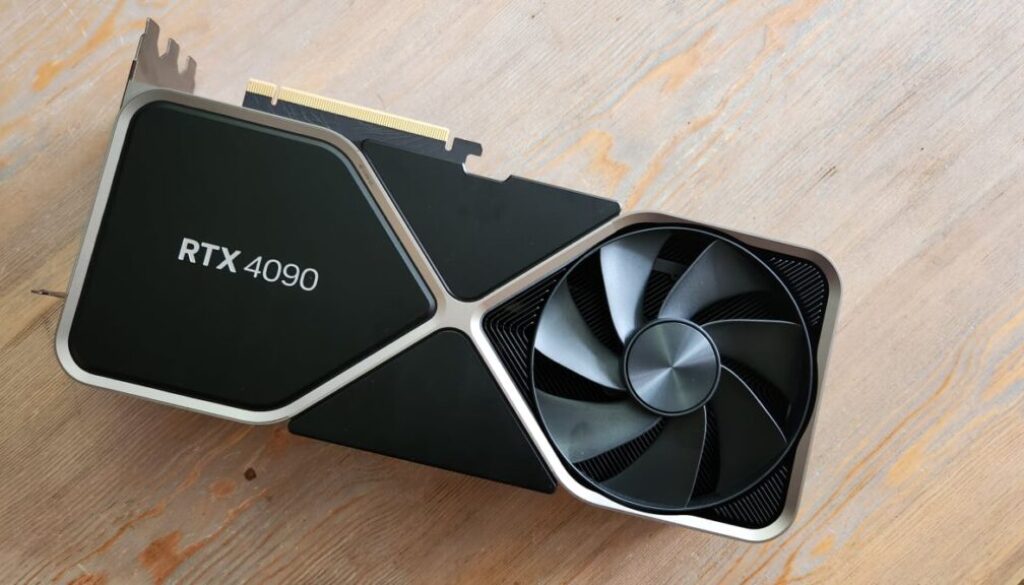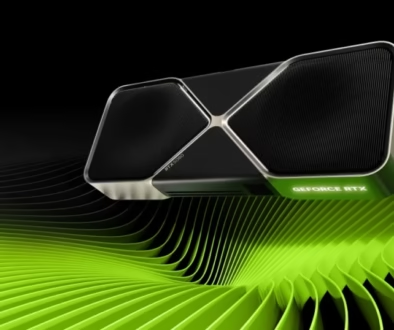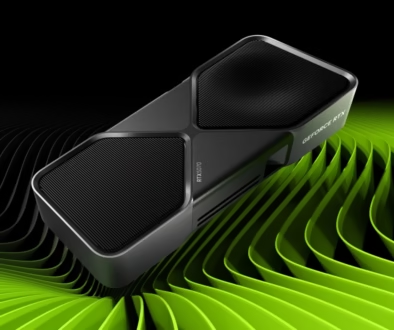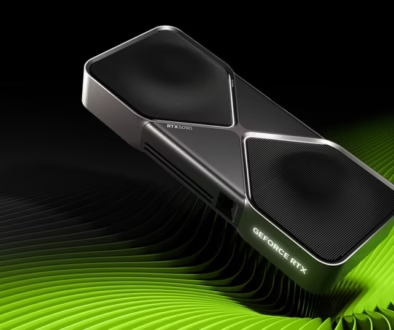The Impact of VRAM on Gaming Performance: How Much Do You Need in 2025?
When you purchase through links on our website, we may earn an affiliate commission.

Image Credit: Reviewed – USA Today
Picture this: You’ve just fired up the latest AAA title, eagerly anticipating stunning visuals and smooth gameplay. But instead, you’re greeted by stuttering graphics and texture pop-ins. Talk about a gaming nightmare! If you’ve ever experienced this, you might be facing a VRAM bottleneck.
VRAM, or Video Random Access Memory, is the unsung hero of gaming graphics. It’s the dedicated memory on your graphics card that stores all those beautiful textures, models, and effects that make your games look incredible. But here’s the million-dollar question: How much VRAM do you need for optimal gaming performance in 2025?
In this deep dive, we’ll explore the crucial role VRAM plays in your gaming experience, from buttery-smooth frame rates to jaw-dropping visual fidelity. We’ll break down VRAM requirements for different resolutions, analyze real-world usage in modern games, and help you make an informed decision for your next GPU upgrade. Whether you’re a casual gamer or a hardcore enthusiast, understanding VRAM is key to getting the most bang for your buck in today’s graphics card market.
What is VRAM and How Does it Affect Gaming?
VRAM, short for Video Random Access Memory, is the specialized memory built into your graphics card. Think of it as a high-speed storage locker for all the visual data your GPU needs to render those stunning game worlds. Unlike system RAM, VRAM is dedicated solely to graphics processing, making it crucial for smooth gaming performance.
When you’re gaming, your GPU constantly shuffles data in and out of VRAM. This includes textures, models, shaders, and other graphical elements. The more VRAM you have, the more high-quality assets your GPU can store and access quickly. This translates to faster load times, reduced texture pop-in, and smoother gameplay.
But VRAM isn’t just about capacity; speed matters too. Modern GPUs use advanced memory technologies like GDDR6 and HBM2, which offer incredible bandwidth. This is especially important when you’re pushing high frame rates or gaming at 4K resolution, where every millisecond counts.
The evolution of VRAM has been a key factor in the advancement of graphics technology. From the early days of 2D sprites to today’s ray-traced environments, VRAM has grown in size and sophistication. This progress has enabled the development of increasingly complex and visually stunning games, pushing the boundaries of what’s possible in virtual worlds.
VRAM Requirements for Different Gaming Resolutions
When it comes to VRAM, resolution is king. The higher the resolution you’re gaming at, the more VRAM you’ll need to maintain smooth performance. Let’s break it down:
4GB of VRAM is typically the bare minimum for 1080p gaming. However, for newer titles with high-quality textures, 6GB or 8GB is recommended for a buffer-free experience. If you’re into modding or using high-resolution texture packs, you might want to aim even higher. If you’re on a tight budget, there are several cost-effective options that can deliver solid performance at this resolution. In fact, you might want to explore some of the top budget-friendly graphics cards for 1080p gaming, which offer a great balance of performance and value.
Stepping up to 1440p, you’re looking at a sweet spot of 8GB to 12GB VRAM. This resolution has become increasingly popular among gamers for its balance of sharpness and performance. With 8GB, you’ll handle most games well, but 12GB gives you more headroom for future titles and higher settings.
4K gaming is where things get serious. Here, 12GB to 16GB of VRAM is ideal. This allows you to crank up those texture settings and enjoy games in all their ultra-high-definition glory. When it comes to 4K gaming, the debate between budget and high-end graphics cards becomes particularly relevant. While premium cards like the RTX 4090 offer unparalleled performance, they come with a significant price tag. It’s worth considering whether such high-end options are genuinely worth it for your specific needs.
For the brave souls venturing into 8K territory, you’ll want all the VRAM you can get – we’re talking 20GB or more. However, 8K gaming is still niche and often requires cutting-edge hardware for playable frame rates.
Remember, these are general guidelines. Some games are more VRAM-hungry than others, and factors like ray tracing can significantly increase VRAM usage.
VRAM Usage in Modern Games: Case Studies
Let’s look at some real-world examples to truly understand VRAM requirements. Modern AAA titles are pushing the boundaries of graphics technology, and with that comes increased VRAM demand.
Take “Cyberpunk 2077” for instance. At 4K resolution with ray tracing enabled, this game can easily consume over 10GB of VRAM. Similarly, open-world games like “Red Dead Redemption 2” and “Microsoft Flight Simulator” are known VRAM hogs, especially when running at high settings.
While not always as demanding, racing simulators and sports games can still benefit from ample VRAM. Titles like “Forza Horizon 5” use high-resolution textures for car models and environments, which can quickly fill up your VRAM buffer.
It’s not just about the present, either. As games evolve, we’re seeing a trend towards higher VRAM usage. Ray tracing, in particular, is a technology that’s becoming more prevalent and demands significant VRAM. Implementing ray tracing can have a noticeable impact on both visual quality and performance, making it an important consideration when assessing VRAM needs.
Interestingly, some games are more VRAM-efficient than others. Esports titles like “Counter-Strike 2” and “Valorant” are optimized to run on a wide range of hardware and typically have lower VRAM requirements. This is great news for budget-conscious gamers who can still enjoy competitive gameplay without breaking the bank on a high-end GPU.
Factors That Influence VRAM Consumption
Several factors can impact how much VRAM your games consume. Understanding these can help you make informed decisions about graphics settings and GPU upgrades.
Texture quality is perhaps the most giant VRAM hog. Higher-resolution textures require more memory to store and display. When you crank up that texture setting from “High” to “Ultra,” you’re telling your GPU to load larger, more detailed texture files into VRAM.
Anti-aliasing techniques, which smooth out jagged edges in games, can also be VRAM-intensive. Particularly, supersampling methods like SSAA can significantly increase VRAM usage as they render the game at a higher resolution before scaling it down.
Mod support and custom textures are another consideration. If you love modding your games with high-resolution texture packs, be prepared for increased VRAM demands. Some mods can push VRAM usage well beyond what the base game requires.
Ray tracing, a technology that simulates realistic lighting and reflections, is becoming more common in modern games. However, it’s also notorious for its high VRAM consumption. Implementing ray tracing can significantly impact visual fidelity and performance, making it a crucial factor when considering VRAM requirements.
Lastly, multi-monitor setups can dramatically increase VRAM usage, especially if you’re gaming across multiple displays. Each additional screen requires more VRAM to render the extended game world.
Signs of Insufficient VRAM in Gaming
Recognizing the signs of VRAM shortage can help you diagnose performance issues and make necessary adjustments. Here are some telltale indicators:
Texture pop-in and slow loading are common symptoms. If you notice textures suddenly appearing or taking a long time to load as you move through a game world, your GPU might be struggling to swap assets in and out of limited VRAM.
Frame rate drops and stuttering are another red flag. When your VRAM is maxed out, your GPU has to constantly fetch data from slower system memory, causing noticeable hitches in gameplay. This is particularly noticeable in open-world games or during fast-paced scenes.
In extreme cases, you might experience crashes or error messages related to memory. Some games will display warnings about low video memory, while others might simply crash to the desktop when they run out of VRAM.
It’s worth noting that these symptoms can sometimes be mitigated by tweaking in-game settings. Lowering texture quality, reducing draw distance, or disabling specific effects can free up VRAM and improve performance. For those with budget GPUs, there are various techniques to optimize performance and squeeze out extra frames, even with limited VRAM.
Remember, while these signs often point to VRAM issues, they can also be caused by CPU bottlenecks or insufficient system RAM. It’s always a good idea to monitor your system’s performance to pinpoint the exact cause of any gaming issues.
How to Check Your VRAM Usage While Gaming
Monitoring your VRAM usage can provide valuable insights into your GPU’s performance and help you optimize your gaming experience. Fortunately, several tools are available to help you monitor your VRAM consumption.
Many modern games come with built-in performance overlays that display VRAM usage alongside other metrics like FPS and GPU temperature. For NVIDIA users, the GeForce Experience overlay offers this functionality, while AMD users can utilize the Radeon overlay.
For more detailed analysis, third-party software like MSI Afterburner is prevalent among gamers and enthusiasts. It provides a customizable on-screen display that can show real-time VRAM usage, along with a host of other GPU metrics. Another great option is HWINFO, which offers in-depth system monitoring capabilities.
When interpreting VRAM usage data, keep in mind that it’s normal for games to utilize a large portion of available VRAM. The key is to watch for situations where VRAM usage is consistently at or near 100%, as this can lead to performance issues.
It’s also worth noting that some monitoring tools can slightly impact performance, especially on lower-end systems. If you’re trying to squeeze every last frame out of your GPU, you might want to explore safe overclocking techniques for budget GPUs, which can provide additional performance gains without requiring more VRAM.
Regularly monitoring your VRAM usage lets you make informed decisions about graphics settings and determine when it might be time for a GPU upgrade.
Balancing VRAM with Other GPU Features
While VRAM is crucial, it’s just one piece of the GPU puzzle. When choosing a graphics card, you must balance VRAM with other essential features for the best overall performance.
The relationship between VRAM and GPU processing power is complex. A GPU with tons of VRAM but weak processing capabilities might struggle with high frame rates, even if it can load high-resolution textures. Conversely, a powerful GPU with limited VRAM might perform well in less demanding games but struggle with texture-heavy titles.
Consider your gaming habits when deciding whether to prioritize VRAM over other GPU specs. If you primarily play esports titles or older games, you might benefit more from a GPU with higher clock speeds and more CUDA cores (for NVIDIA) or stream processors (for AMD) rather than excessive VRAM.
However, prioritizing VRAM becomes more critical if you’re into AAA games with ultra-high-resolution textures or plan on gaming at 4K. The balance between VRAM and other features becomes crucial when comparing high-end GPUs for demanding applications.
Another consideration is future-proofing. As graphics technology advances, games are likely to become more VRAM-hungry. Investing in a GPU with more VRAM than you currently need could extend its useful lifespan.
Ultimately, the key is to find a balance that suits your budget and gaming needs. Sometimes, a mid-range card with a good balance of VRAM and processing power can offer better value than a top-tier card. When choosing between budget and high-end graphics cards, it’s essential to consider whether the price difference is justified by the performance gains in your specific use case.
Conclusion
As we’ve explored, VRAM plays a crucial role in gaming performance, influencing everything from texture quality to overall smoothness of gameplay. In 2025, the amount of VRAM you need primarily depends on your gaming resolution, the types of games you play, and your expectations for visual quality.
Remember, these are general guidelines. Your specific needs may vary based on the games you play and how you like to play them. If you’re a modding enthusiast or someone who always cranks settings to ultra, you might benefit from having more VRAM than the average gamer.
When shopping for a new GPU, consider VRAM alongside other important factors like core clock speeds, ray tracing capabilities, and overall performance benchmarks.
Ultimately, the goal is to find a graphics card that provides the best balance of performance, features, and value for your specific gaming needs. By understanding the role of VRAM and how it impacts your favorite games, you’ll be well-equipped to make the right choice for your next GPU upgrade.
In the end, the perfect amount of VRAM is the amount that lets you play your favorite games in your preferred settings without breaking the bank. Happy gaming!



Budget GPUs: AMD vs. NVIDIA Showdown - Which Offers the Best Bang for Your Buck in 2024? -
September 3, 2024 @ 9:25 am
[…] features you should expect? Well, most budget GPUs now come with at least 6GB of VRAM – trust me, you’ll want that for texture-heavy games. You’ll also see support for […]
Understanding GPU Specs: A Comprehensive Guide for Budget Gamers in 2024 -
September 4, 2024 @ 3:57 pm
[…] there’s VRAM or Video RAM. This is where your GPU stores textures and other data it needs quick access to. […]
Best GPUs to Buy in 2024 -
December 3, 2024 @ 1:18 pm
[…] to its 8GB of GDDR6 VRAM, the RX 6600 handles games with high-resolution textures well, though it may struggle with newer […]
AMD Radeon RX 6600 vs. Intel Arc B580: Has the Budget King Been Dethroned? -
December 28, 2024 @ 1:11 pm
[…] also benefits from a much higher memory bandwidth (456 GB/s vs. 224 GB/s) and a larger 12GB GDDR6 VRAM with a wider 192-bit memory bus as compared to the RX 6600’s 8GB VRAM with 128-bit memory […]
Intel Arc B580 Review -
December 31, 2024 @ 7:41 am
[…] a crucial aspect that sets the B580 apart is its 12GB of VRAM. This generous memory capacity is a significant advantage, especially at its price point. Most […]
NVIDIA GeForce RTX 5080 Review: The Next Big Leap or a Gimmick?
February 8, 2025 @ 3:46 pm
[…] of the biggest concerns with the RTX 5080 is its 16GB of VRAM, which feels insufficient for a next-generation GPU in this price range. Modern games are becoming […]